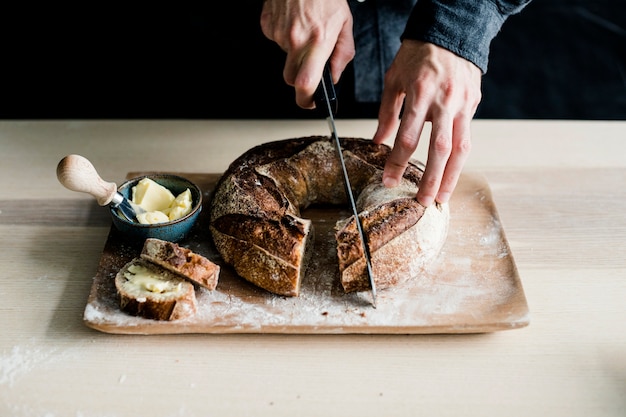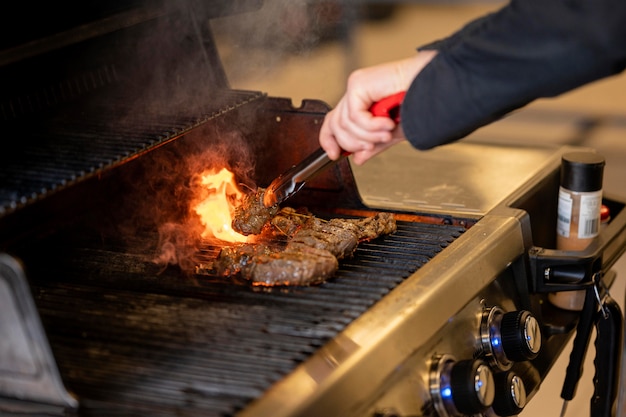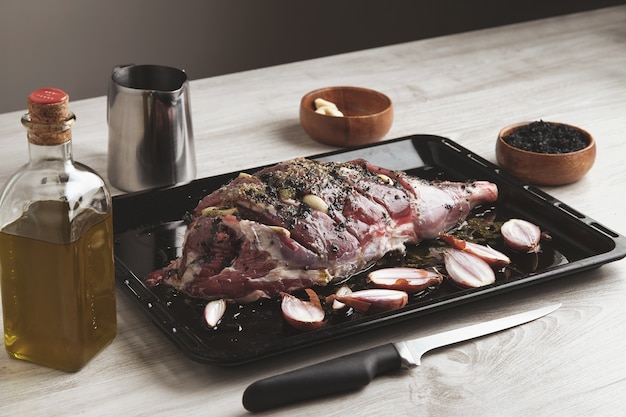There's something truly satisfying about a perfectly cooked ribeye steak. That beautiful sear, the melt-in-your-mouth tenderness, and the rich, savory flavour... it's a culinary experience that just can't be beaten. And you know what? You don't need a fancy grill or a professional kitchen to achieve it. With a trusty cast iron pan and a few simple techniques, you can have a restaurant-worthy ribeye right in your own kitchen. So, grab your apron, let's get our hands dirty, and dive into the world of sizzling, juicy steak perfection.
(Part 1) choosing the right cut: The Foundation of a Great Steak

First things first, you need to pick the right cut of beef. Now, I'm a ribeye fanatic. There's a reason it's the king of steaks, you know. That beautiful marbling – those white streaks of fat running through the meat – is what makes a ribeye so juicy, flavorful, and oh-so-tender. It's a real game-changer, trust me.
The Secret to Marbling
Think of it this way: the fat in a ribeye melts as it cooks, basting the meat from the inside out. It's like a built-in self-moisturizer for your steak. Plus, that fat adds a richness and depth of flavour you just can't get from leaner cuts. It's a culinary symphony, really.
Thickness is Key
When you're at the butcher's, look for a ribeye that's at least an inch thick. Anything thinner and it'll cook too quickly, leaving you with a tough, dry steak. And don't be shy about going for a big one! A thicker steak takes longer to cook, which means it has more time to retain moisture and develop that lovely, even sear. It's worth the extra time and effort, I promise.
(Part 2) The Art of Preparation: Getting Your Steak Ready for Stardom

Now that you've got your perfect ribeye, it's time to get it ready for its starring role on your stovetop. It's a simple process, but it makes all the difference in the world.
The Salt Game: A Little Patience Goes a Long Way
Some folks swear by salting their steak the night before, letting it sit in the fridge overnight. Others prefer to salt just before cooking. I'm in the latter camp. It helps to draw out some of the surface moisture, resulting in a more concentrated flavour and a crispier sear. Plus, it gives the salt a chance to dissolve into the meat, rather than forming a crust on the surface.
Pepper Power: A Touch of Spice
Don't forget about the pepper! I always use freshly ground black pepper. It adds a burst of flavour and a subtle bit of heat that complements the richness of the ribeye. Just a generous grinding over both sides is all you need.
The Pat Down: A Crucial Step
Finally, before you hit the pan, pat the steak dry with a paper towel. This is a critical step! Moisture on the surface of the steak will hinder the searing process, resulting in a steamed steak instead of a beautifully browned one. So take the time to pat it dry, it's worth it!
(Part 3) The Stovetop Showdown: Mastering the Pan Searing

Alright, here we go! Now it's time to unleash your inner chef and bring that ribeye to life on the stovetop. The key to a perfect stovetop ribeye is a good quality cast iron pan. It's a true workhorse in the kitchen.
Cast Iron: A Kitchen Essential
Cast iron pans heat up evenly and hold heat incredibly well, which is crucial for achieving that crispy, golden-brown sear. They're also incredibly durable, so they'll last you a lifetime if you care for them properly. Think of it as an investment in your culinary future.
Heating Up: The Pan Needs to Be Hot!
Get your cast iron pan nice and hot over medium-high heat. I usually let it heat up for about 5 minutes, until it's smoking. You can test it by adding a drop of water – if it sizzles and evaporates immediately, you're good to go. This high heat is what gives your steak that amazing crust.
Searing: The Key to Juicy, Flavourful Steak
Now, carefully place the steak in the screaming hot pan. You'll hear a satisfying sizzle, which is the sound of deliciousness happening! Resist the urge to move it around too much. Let it cook for about 3-4 minutes per side for a medium-rare steak. You want to let that beautiful crust form without disturbing it.
The Flip: One Time, and One Time Only
Once the first side has a lovely golden-brown crust, it's time to flip the steak. This is a critical moment. Avoid flipping it multiple times. Each flip disrupts the cooking process and can lead to a less even sear.
Checking Doneness: The Finger Test
As the steak cooks, you can check its doneness by gently pressing it with your finger. If it feels firm, it's well-done. If it's slightly springy, it's medium. And if it's very soft, it's rare. It's a simple, hands-on method that gives you a good idea of how your steak is progressing.
(Part 4) Resting: The Secret to Juicy, Tender Steak
Now, the most important part: resting the steak. This is often overlooked, but it's crucial for achieving that perfectly juicy and tender steak. Think of it as the grand finale of your steak-cooking masterpiece.
Why Rest?
As the steak cooks, the juices get pushed towards the center. When you cut into it immediately, these juices spill out, leaving you with a dry and disappointing steak. Resting allows the juices to redistribute evenly throughout the meat, resulting in a more flavorful, tender, and juicy steak. It's a simple step, but it makes all the difference.
How Long to Rest
Let the steak rest for at least 5-10 minutes before cutting into it. This might seem like a long time, but trust me, it's worth it. Place it on a cutting board, cover it loosely with foil, and let those juices settle in.
(Part 5) Adding Extra Flavour: The Finishing Touches
Now, your ribeye is cooked to perfection, but why stop there? We can add some extra flavour to make it truly unforgettable. Butter, herbs, garlic, the possibilities are endless. It's time to get creative and unleash your inner flavour master.
The Classic Garlic and Butter Combo
Before resting the steak, I like to add a knob of butter and a few cloves of garlic to the pan. Let the butter melt and the garlic infuse, then spoon it over the steak as it rests. It's a classic combination that never fails to elevate the flavour of a steak. The garlic adds a bit of savory heat, while the butter creates a rich and luscious sauce that melts over the steak as it rests.
Herbs for a Fresh Touch
If you're feeling adventurous, you can add some fresh herbs to the pan. Rosemary, thyme, and sage all pair beautifully with ribeye. Just a few sprigs, added towards the end of the cooking time, will infuse the steak with a wonderful aroma and flavour.
(Part 6) Serving Time: Presenting Your steak masterpiece
Alright, it's time to enjoy the fruits of your labour! Your beautifully cooked, flavourful ribeye is ready to be devoured. I like to keep things simple and serve my ribeye with a classic side salad and some roasted vegetables. It's a combination that lets the steak shine and complements its rich flavour.
The Importance of Presentation
Don't underestimate the power of presentation. Even the simplest of dishes can look stunning with a little effort. Arrange your steak on a nice plate, maybe add a sprig of rosemary or a few slices of lemon for a touch of colour. Your steak deserves to be presented with the same care and attention you put into cooking it.
(Part 7) steak temperature Chart: Knowing Your Doneness
So, you want a perfect medium-rare ribeye, but how do you actually know when it's cooked to your liking? Well, there's a handy little cheat sheet that can help. Take a look at this:
| Doneness | internal temperature (Fahrenheit) | Internal Temperature (Celsius) |
|---|---|---|
| Rare | 125-130 | 52-54 |
| Medium-Rare | 130-135 | 54-57 |
| Medium | 135-140 | 57-60 |
| Medium-Well | 140-150 | 60-65 |
| Well-Done | 150-160 | 65-71 |
A meat thermometer is your best friend when it comes to achieving the perfect doneness. Just insert it into the thickest part of the steak, making sure you avoid touching the bone.
Don't Be Afraid to Experiment
Don't be afraid to experiment with different levels of doneness. Some folks love a juicy, rare steak, while others prefer it well-done. It's all about personal preference. The important thing is to cook your steak to your liking, and enjoy the process!
(Part 8) Tips and Tricks: Elevating Your Steak Game
Now that you've got the basics down, let's explore some little tips and tricks that can help you take your ribeye game to the next level. These are the secrets that will make your steak truly exceptional.
Invest in a Cast Iron Pan
As I mentioned earlier, a good quality cast iron pan is an essential tool for any steak enthusiast. It's a versatile tool that you can use to sear steaks, cook vegetables, and even bake bread.
Seasoning Your Cast Iron Pan
If you're new to cast iron, you'll need to season it before you use it. This involves coating the pan with a layer of oil and baking it in the oven. Seasoning creates a non-stick surface that prevents food from sticking to the pan and also helps to protect the cast iron from rust. You can find countless online resources with detailed instructions on how to season a cast iron pan.
Don't Overcrowd the Pan
When you're searing your steak, don't try to cram too much into the pan. Overcrowding the pan will lower the temperature, preventing the steak from getting a good sear. It's best to cook your steaks in batches.
Rest, Rest, Rest
I can't emphasize this enough: let your steak rest. It's the key to achieving that juicy, tender steak. Allowing the juices to redistribute ensures a truly satisfying culinary experience.
Experiment with Flavours
Don't be afraid to experiment with different flavours. You can use different herbs, spices, and even sauces to add your own unique touch to your steak. There are no rules, just have fun and explore!
Enjoy the Process
Most importantly, enjoy the process. Cooking a steak should be a relaxing and enjoyable experience. Put on some music, grab a glass of wine, and let the aromas of sizzling steak fill your kitchen. It's a truly rewarding experience.
(Part 9) FAQs: Answers to Your Burning Questions
I know you've got questions. Let's get to the bottom of them, and make sure you're equipped with all the knowledge you need to become a steak master.
Q1: Can I cook a ribeye in a regular pan?
Of course! A cast iron pan is ideal, but you can definitely use a regular pan. Just make sure it's heavy-bottomed and heats up evenly. You might need to adjust the cooking time depending on your pan.
Q2: How long should I cook a ribeye for medium-rare?
The cooking time will vary depending on the thickness of your steak and the heat of your pan. But as a general guideline, you should cook a ribeye for about 3-4 minutes per side for medium-rare. Use a meat thermometer to check the internal temperature to be sure.
Q3: What if I overcook my steak?
Don't worry, it happens to the best of us! If you overcook your steak, it won't be as juicy and tender. However, you can still salvage it by making a steak sandwich or adding it to a stew or soup.
Q4: What can I serve with a ribeye steak?
The world is your oyster! There are countless sides that go well with ribeye steak. Some popular choices include mashed potatoes, roasted vegetables, asparagus, salad, and garlic bread. You can also get creative and experiment with different flavour combinations.
Q5: How do I store a ribeye steak?
You can store a ribeye steak in the fridge for 3-5 days. Wrap it tightly in plastic wrap or place it in an airtight container. You can also freeze a ribeye steak for up to 3 months. Thaw it in the fridge overnight before cooking.
There you have it, folks! That's my take on cooking a perfect ribeye steak. Now go forth, grab yourself a good cut of beef, and put these tips to the test. You'll be amazed at the results. Enjoy the sizzling, juicy, and flavourful journey!
Everyone is watching

Corn on the Cob: The Ultimate Guide to Perfectly Cooked Ears
Healthy MealsAh, corn on the cob. Just the name evokes images of sunny days, barbecues, and that sweet, juicy flavour that ...

Scallops: The Ultimate Guide to Perfect Cooking
Healthy MealsAh, scallops. Those delicate, sweet, and utterly delicious morsels of the sea. They hold a special place in my...

Spaghetti Squash: The Ultimate Guide to Cooking and Serving
Healthy MealsRemember that time you saw spaghetti squash at the supermarket, looking all bumpy and strange, and thought, "W...

Salmon Cooking Times: Perfect Guide for Every Recipe
Healthy MealsLet me tell you, cooking salmon is an art form. It's all about getting that perfect balance: juicy and tender,...

Ham Cooking Time: How Long to Bake, Smoke, or Boil a Delicious Ham
Healthy MealsAh, ham. It's a classic, isn't it? A real crowd-pleaser, especially around holidays. And when done right, it'...
